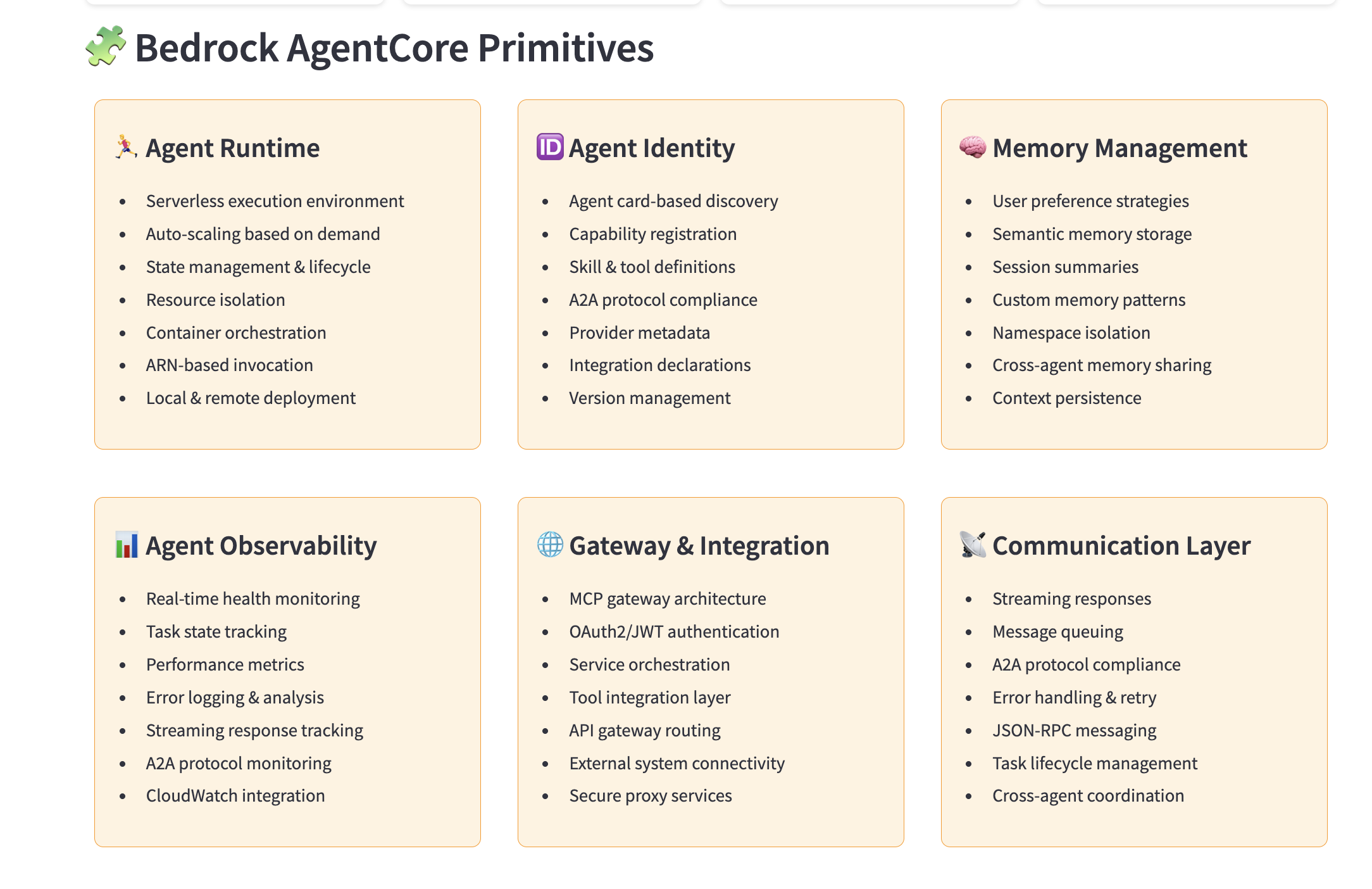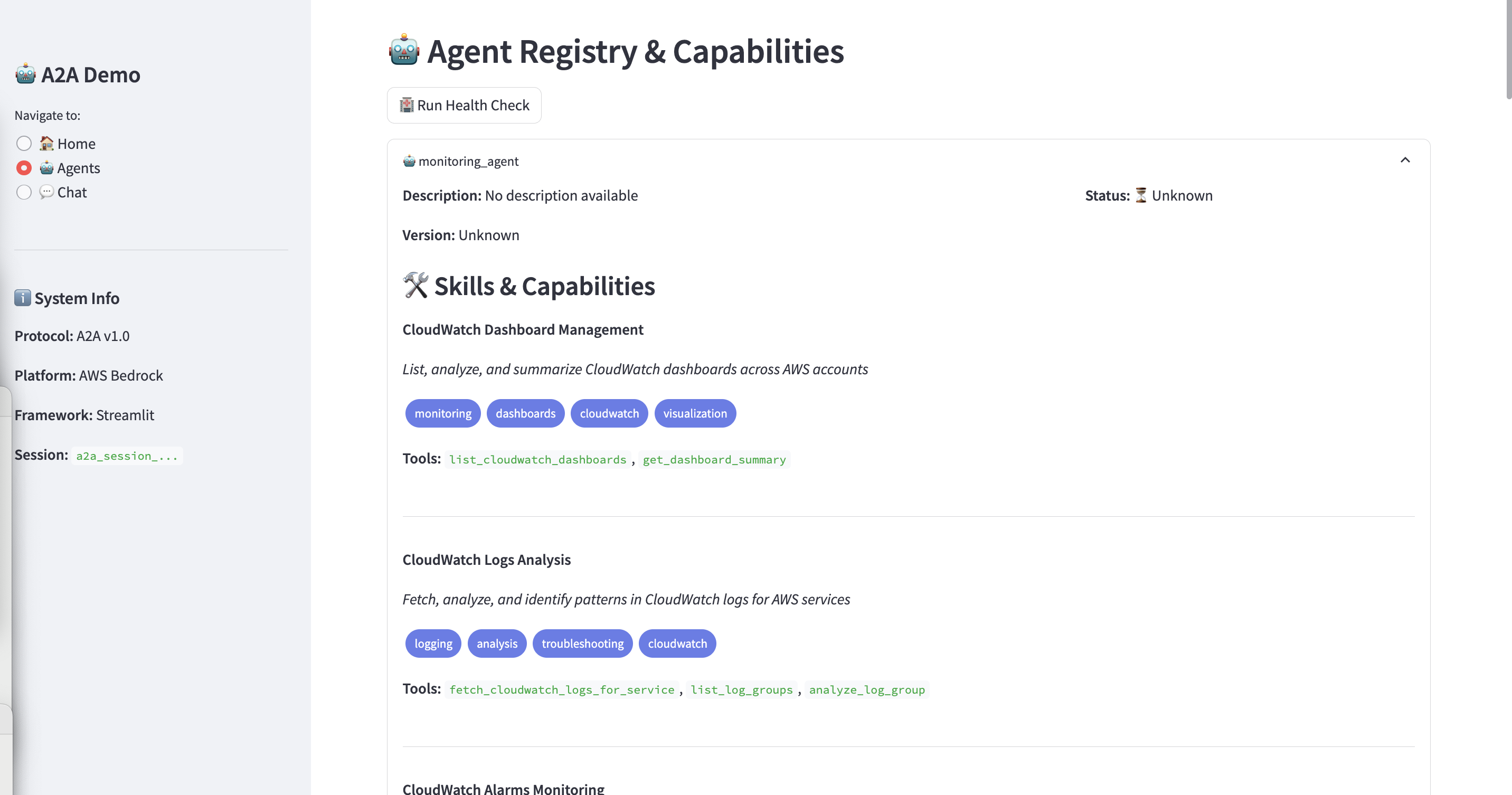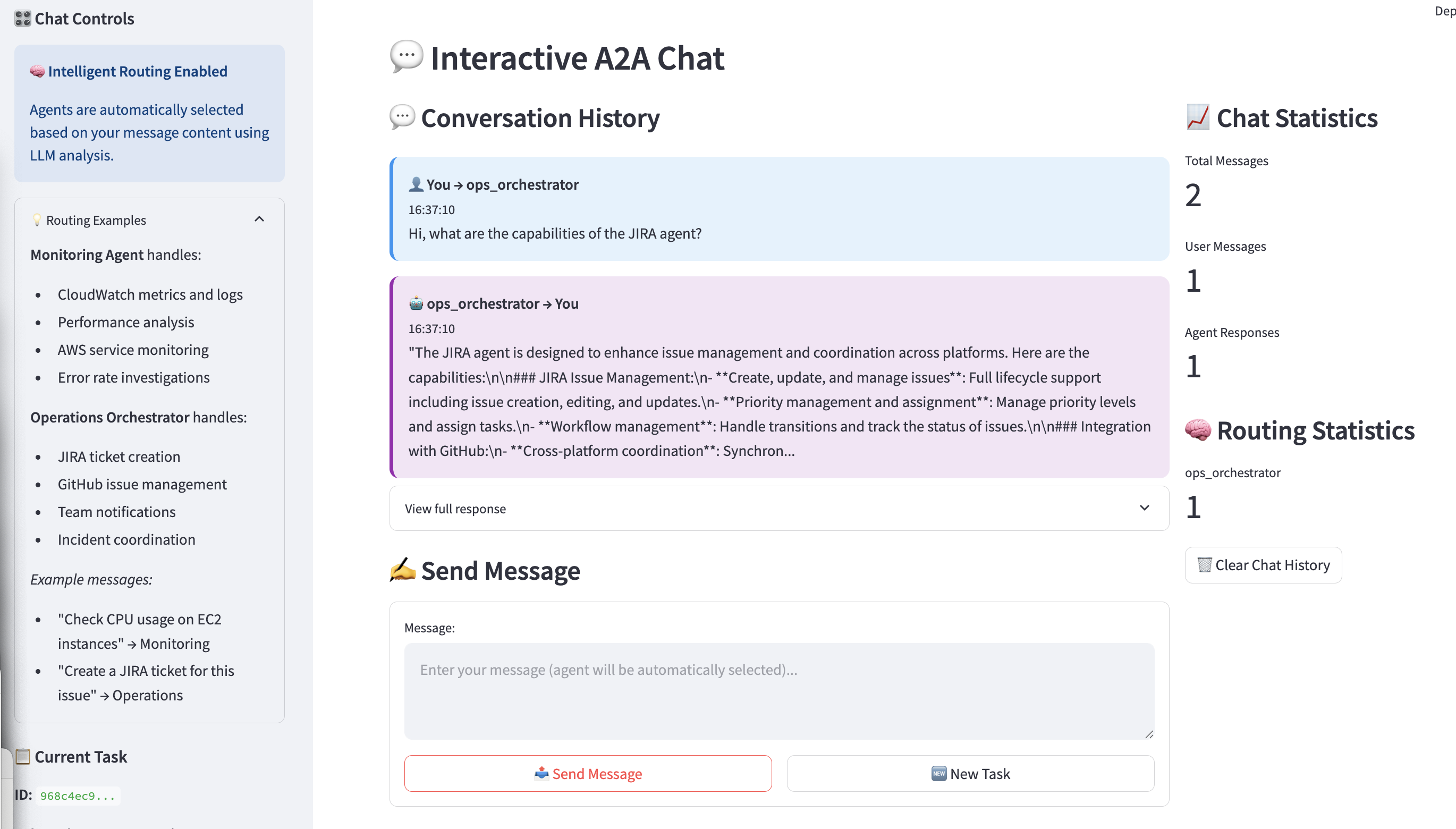A2A Multi-Agents AgentCore Documentation
Multi-Agent System with AWS Bedrock AgentCore: Comprehensive Guide

Welcome to the comprehensive documentation for the A2A Multi-Agents AgentCore system - a sophisticated multi-agent framework built on AWS Bedrock AgentCore for automated operations, monitoring, and incident management.
System Overview
This multi-agent system demonstrates sophisticated implementation of AWS Bedrock AgentCore primitives through two coordinated agents: a Monitoring Agent for AWS resource analysis and an Ops Orchestrator Agent for automated incident management and operations coordination.

Key Features
Enterprise-Grade Architecture: Built on AWS Bedrock AgentCore with proper authentication, memory management, and observability Multi-Agent Collaboration: Sophisticated agent-to-agent coordination for complex operational workflows Comprehensive AWS Integration: Deep integration with CloudWatch, JIRA, GitHub, and other enterprise services Advanced Memory Management: Persistent memory across sessions with semantic understanding and user preferences Secure Gateway Architecture: MCP-based gateway with OAuth2/JWT authentication and proper access controls Production-Ready Deployment: Supports both local development and managed cloud deployment modes
AWS Bedrock AgentCore Primitives

Your implementation showcases sophisticated usage of AWS Bedrock AgentCore’s modern primitives, representing current best practices in enterprise AI agent development.
Memory Management Primitives
User Preference Memory Strategy: Maintains user-specific configurations and preferences, allowing agents to adapt their behavior based on individual needs and past interactions. Uses namespace isolation (/users/{actorId}) to ensure proper data separation.
Semantic Memory Strategy: Provides contextual understanding and knowledge retention across sessions. Enables agents to build understanding of your environment, recognize patterns, and apply previous learning to new situations.
Summary Memory Strategy: Maintains session-level summaries and conversation context, ensuring coherent conversations across multiple interactions while managing context window limitations effectively.
Custom Memory Strategies: Specialized memory implementations for specific use cases like monitoring issue tracking and incident response patterns. These strategies use custom extraction and consolidation prompts optimized for technical content.
Agent Registry & A2A Communication

The system supports multiple communication patterns:
Direct Invocation: Each agent can be invoked directly for specific tasks Agent-to-Agent (A2A): Agents can communicate with each other for coordinated workflows Gateway-Mediated: All external service interactions go through the secure MCP gateway Memory-Shared: Agents can access shared memory contexts for coordination
A2A Protocol Features
- Intelligent Agent Routing: Automatically routes requests to the most appropriate agent based on task type and capabilities
- Task Coordination: Enables complex multi-step workflows that span multiple agents
- Context Preservation: Maintains conversation context across agent handoffs
- Session Management: Tracks multi-agent conversations and task lifecycles
- Health Monitoring: Real-time monitoring of agent status and availability
System Components
🔍 Monitoring Agent
AWS Bedrock AgentCore runtime for monitoring CloudWatch logs, metrics, dashboards, and other AWS services.
Core Capabilities:
- CloudWatch Integration: Complete integration with CloudWatch logs, metrics, dashboards, and alarms
- Intelligent Analysis: Uses advanced language models to analyze log patterns and identify anomalies
- Dashboard Management: Can list, analyze, and summarize CloudWatch dashboards
- Alarm Coordination: Retrieves and analyzes CloudWatch alarms with remediation suggestions
🤝 Ops Orchestrator Agent
Multi-agent system for automated incident triaging, ChatOps collaboration, and report generation.
Multi-Agent Architecture:
- Lead Agent (Issue Triaging): Analyzes incidents and coordinates response actions
- ChatOps Agent: Integrates with Teams, Slack, and Gmail for team coordination
- Ticket Creator Agent: Handles automated ticket creation in JIRA and PagerDuty
Service Integrations

JIRA Integration
Comprehensive JIRA REST API integration supporting issue creation, updates, project management, and workflow automation. Includes proper authentication with API tokens and robust error handling.
GitHub Integration
Full GitHub API integration for repository management, issue tracking, gist creation, and documentation maintenance. Supports both public and private repositories with appropriate permission handling.
Communication Platforms
Integration with major communication platforms for real-time notifications, status updates, and team coordination during incident response.
ChatOps Integration

The ChatOps integration provides:
- Real-time Notifications: Instant alerts and updates to relevant team channels
- Interactive Commands: Direct agent interaction through chat interfaces
- Status Updates: Automated progress reports during incident resolution
- Team Coordination: Seamless collaboration between human operators and AI agents
Quick Start
Prerequisites
- AWS Account and Credentials: Ensure AWS credentials are configured
- IAM Execution Role: Create an IAM role with permissions for:
- Amazon Bedrock access
- CloudWatch logs/metrics access
- Any other AWS services the agent needs
- Required Python Packages: Install dependencies from requirements.txt
Environment Setup
Create a .env file or export the following environment variables:
# AWS Configuration
export AWS_REGION="us-east-1"
export AWS_ACCOUNT_ID="your-account-id"
# JIRA Integration
export JIRA_USERNAME="your-jira-username"
export JIRA_API_TOKEN="your-jira-api-token"
export JIRA_DOMAIN="yourcompany.atlassian.net"
# GitHub Integration
export GITHUB_TOKEN="ghp_your_github_token"
Architecture Deep Dive
┌─────────────────────────────────────────────────────────────┐
│ AWS Bedrock AgentCore │
├─────────────────────────────────────────────────────────────┤
│ ┌─────────────────────┐ ┌─────────────────────────────┐ │
│ │ Monitoring Agent │ │ Ops Orchestrator Agent │ │
│ │ │ │ │ │
│ │ • CloudWatch Logs │ │ • Lead Agent (Triaging) │ │
│ │ • Metrics Analysis │ │ • ChatOps Agent │ │
│ │ • Dashboard Review │ │ • Ticket Creator Agent │ │
│ │ • Alarm Management │ │ • Multi-Agent Coordination │ │
│ └─────────────────────┘ └─────────────────────────────┘ │
├─────────────────────────────────────────────────────────────┤
│ Shared Infrastructure │
│ ┌─────────────────────────────────────────────────────────┐ │
│ │ • Memory Management (User Prefs, Semantic, Summary) │ │
│ │ • MCP Gateway (Authentication, Tool Integration) │ │
│ │ • Observability (OpenTelemetry, CloudWatch Logging) │ │
│ │ • Runtime Management (AgentCore Runtime, Local Mode) │ │
│ └─────────────────────────────────────────────────────────┘ │
└─────────────────────────────────────────────────────────────┘
Getting Started
Choose your agent based on your needs:
- For AWS Monitoring: Start with the Monitoring Agent
- For Operations Management: Begin with the Ops Orchestrator Agent
Bring Your Own Agent (BYOA)
The A2A framework supports bringing your own custom agents into the ecosystem. Here’s how:
Agent Requirements
- AWS Bedrock AgentCore Compatibility: Your agent must be built using AWS Bedrock AgentCore primitives
- Memory Management: Implement proper memory strategies for context preservation
- A2A Protocol Support: Include capability cards and communication interfaces
- Authentication: Support for OAuth2/JWT authentication through the MCP gateway
Integration Steps
- Create Agent Card: Define your agent’s capabilities in JSON format
- Register with A2A: Add your agent to the agent registry
- Implement Communication: Support standardized request/response patterns
- Deploy Runtime: Deploy your agent to AWS Bedrock AgentCore
- Test Integration: Verify A2A communication and coordination
Example Agent Card
{
"agent_name": "custom_agent",
"description": "Custom agent for specialized tasks",
"capabilities": [
{
"category": "analysis",
"skills": ["data_processing", "report_generation"]
}
],
"interfaces": {
"a2a_protocol": "v1.0",
"authentication": "oauth2",
"memory_support": true
}
}
Security Best Practices
- Credential Management
- Use environment variables, not hardcoded credentials
- Rotate API tokens regularly
- Use IAM roles with minimal required permissions
- Network Security
- Use HTTPS for all external API calls
- Implement VPC endpoints for AWS services
- Consider private subnets for production deployments
- Access Control
- Implement least-privilege IAM policies
- Use OAuth2 scopes to limit API access
- Regularly audit service integrations
Support
For issues and questions:
- Check the troubleshooting sections in each agent’s documentation
- Review AWS CloudWatch logs
- Verify configuration against examples
- Check service status of integrated APIs
This documentation provides comprehensive guidance for deploying and using the A2A Multi-Agents AgentCore system with AWS Bedrock.